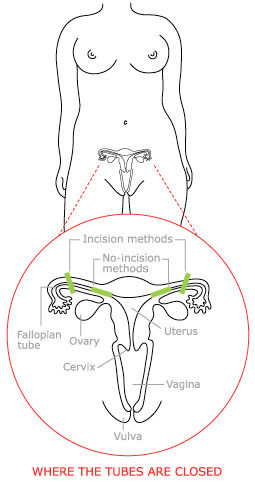
How Does Sterilization Work?
Eggs are made in a woman's ovaries. One egg is released each month. It passes through one of the Fallopian Tubes toward the uterus. Sterilization blocks each tube. Pregnancy cannot happen if sperm cannot reach the egg.
What Are the Types of Sterilization?
There are a few different types of sterilization. One type does not require an incision — a cut. It is called hysteroscopic sterilization. All the other methods require an incision.
Your doctor or nurse can help you decide which kind of sterilization might be right for you and answer any questions you may have. Your medical history, including your weight and previous surgeries, may influence which kind will be best and safest for you.

Does Sterilization Hurt?
Your health care provider will give you medicine to make sterilization as comfortable as possible. Numbing medication and/or sedatives will be used. The choice depends on your health and the method of sterilization being used. Conscious sedation allows you to be awake but deeply relaxed. Local and regional anesthesia block the feeling of pain in certain areas of your body. These are much safer than general anesthesia.
General anesthesia is entirely painless. It allows you to sleep through the procedure.
When you get local or regional anesthesia, you may feel brief discomfort. The pain is relieved with medications and, sometimes, sedatives. Most likely, you will feel little or no discomfort during the procedure.
How Will I Feel After Sterilization?
The discomfort you feel after the procedure depends on your general health, the type of procedure, and how well you deal with pain. You may feel tired and have slight pain in your abdomen. You may occasionally feel dizzy, nauseous, bloated, or gassy, or have shoulder pain or abdominal cramping. People who use Essure may have vaginal discharge that's clear or like a light menstrual period. Most symptoms will last 1–3 days.
Contact your health care provider immediately if you
-
bleed from an incision
-
develop a rash or fever
-
have difficulty breathing
-
have fainting spells
-
have severe, continuous abdominal pain
-
have unusual discharge or odor from your vagina
How Long Does It Take to Recover from Sterilization?
It depends on your general health, lifestyle, and the method of sterilization that you use. With mini-laparotomy and laparoscopy, recovery is usually complete in a day or two. You may want to take it easy for the next week or so. In any case, you should avoid heavy lifting for about one week. Recovery from sterilization with Essure is faster — some women return to normal activities the same day as the procedure. Others take a day or two.
Talk with your health care provider about when it's safe to start having sex again. Remember, if you've had Essure, you need to use another birth control method until your health care provider confirms that your tubes are blocked.



